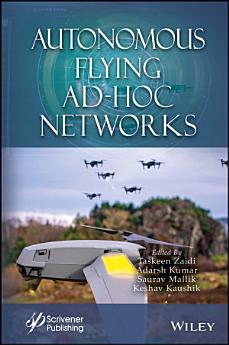Autonomous Flying Ad-Hoc Networks
About this ebook
Flying ad-hoc networks (FANETS) are emerging as an innovative technology in the Unmanned Aerial Vehicles (UAV) space, which has proven its usefulness in urban surveillance, disaster management, and rescue operations. In FANETs, a swarm of UAVs are locally connected together through a base station and the nearby environment to gather the information. FANETs are able to cover larger distances than its predecessors, MANETs (Mobile Ad-hoc Networks) and VANETs (Vehicle Ad-Hoc Networks), making them an ideal solution for gathering vital data. As artificial intelligence is implemented across a number of industries, this technology has the capability to train large datasets. Researchers are exploring ways to improve AI algorithms and quantum computing using this technology. Autonomous Flying Ad-Hoc Networks offers comprehensive coverage of the fundamentals of FANET technology by comparing the differences between FANETs, MANETs, and VANETs, including their characteristics, features, and design models, and discussing the applications and challenges of FANET adoption.
About the author
Taskeen Zaidi, PhD works in the School of Computer Science and Information Technology at Jain University with over 12 years of research and teaching experience. She has published over 40 research papers in international journals, conferences, and workshops. Her areas of interest include cloud computing, ad-hoc networks, distributed computing, and mobile application development.
Adarsh Kumar, PhD is an associate professor in the School of Computer Science at the University of Petroleum and Energy Studies. He has published over 120 research papers in reputed journals, conferences, and workshops. His primary research interests include cybersecurity, cryptography, network security, and ad-hoc networks.
Saurav Mallik, PhD is a research scientist in the Department of Pharmacology and Toxicology at the University of Arizona. He has edited one book and coauthored over 82 research papers in peer-reviewed international journals, conferences, and book chapters. His research areas include data mining, computational biology, bioinformatics, biostatistics, and machine learning.
Keshav Kaushik, PhD is an assistant professor in the Systemic Cluster under the School of Computer Science at the University of Petroleum and Energy Studies with over eight years of teaching experience. He has edited over ten books and published over 65 research papers in international journals and conferences. His research focuses on cybersecurity, digital forensics, and the Internet of Things.








